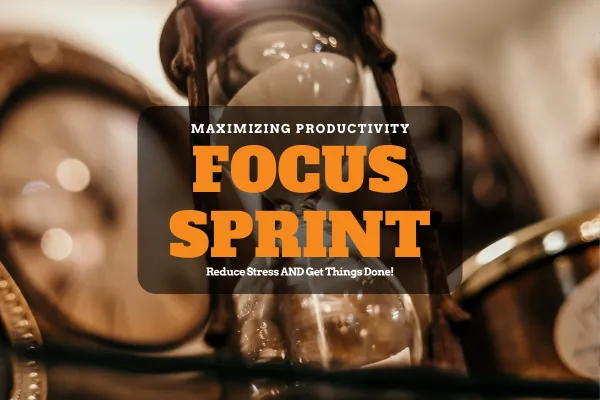Training Topic Library

Focus Sprints
Ever feel overwhelmed by a task & then procrastinate? Focus sprints can help! Break down big goals into short, intense bursts of work with mini breaks in between. This can boost productivity & reduce stress. #productivity #timemanagement
Crazy question…have you ever had something to do that was a bit overwhelming or maybe even underwhelming that needed to be done? Of course, you have we all have! In either case, a normal response is to procrastinate or drudge through it. Ultimately, the work takes way longer than it should have, the stress that goes along with it can be overwhelming, and the quality of work or results are often not our best.
Focus Sprint | Short blasts of highly intense focus help rid ourselves of the urge to procrastinate, the stress that goes with it, and boredom with tedious tasks and help provide both more efficient and higher quality results. Some tasks give us more energy and are better aligned with our internal motivators and some tasks are best delegated to someone else, if possible. That’s another conversation altogether!
Activity Micro-bites | Breaking down your Focus Sprint into micro-bites of activity helps to eliminate procrastination and generates traction almost immediately. Let’s face it, big daunting goals like learning to dance, learning a foreign language, improving your health and fitness, developing a new product, and prospecting can be overwhelming. When broken down into micro-bites, they become manageable and reasonable, and we start to believe it’s possible. Over time, when we put all these small, almost insignificant, blocks together end to end we can build a life by design and a life of purpose.
Focus Sprint
Goal Chunking – take the goal or task and break it down into much smaller pieces. No matter how big the goal or task it can be broken down into much smaller, more manageable chunks or basic activities. Then further break down these pieces to activities you can control.
Ideally, each chunk will require about 25 minutes of intense focus and deliberate action to accomplish. For example, I’m writing a book and it seems like I have about 24 hours of intense focus and deliberate action prior to sending the rough draft to my editor. I can divide 24 hours into roughly (24 hours X 60 minutes/hr / 25 minutes) fifty-eight – 25-minute blocks of time.
Each chunk or micro-bite will have its own ideal outcome. What progress or outcome would you like to accomplish within the given time?
Make sure to adjust your ideal outcomes for each Focus Sprint, as you’ll have actual data from the sprint before and a better understanding of what is possible in the next Focus Sprint.
It is essential to keep your ideal outcomes completely doable to protect and grow your goal-crushing self-esteem. If missed, lower your expectations, and, if you crushed it, raise your ideal outcome expectations.
Calendar Blocking – start placing 1-hour blocks in your calendar for 1 to 2 hours at a time plus 15-30 minutes for a non-work break. Each block represents two Focus Sprints, and are ideally placed back to back. If you’re on a deadline, you can add more blocks back to back. Word to the wise: Let your calendar be your boss and respecting your commitments to yourself helps to reinforce and grow your self-esteem. You can do this every morning or weekly.
Block Timing – you have as many options to try and settle on what you believe is most effective for your own work style and for a specific project.
12 1/2 minutes working 2 1/2 minutes stretching (15-minutes)
25 minutes working 5 minutes stretching (30-minutes)
50 minutes working 10 minutes stretching / walking around the block (my preferred block) (1-hour)
Add 30 minutes each 2 hours for a scheduled non-work break.
Advance Planning
Weekly | In accordance with your goals and ideal outcomes for the week, how many Focus Sprints will help you achieve the next milestone? Block them off in your calendar in 1 hour and 15 minutes or 2 1/2 hour chunks to allow for your sprint and your non-work breaks.
Typically, I recommend doing this when you’re not stressed. In fact, this could be a Focus Sprint task at the end of your working day on Friday (highly recommended), Sunday evening after everything from the weekend has calmed down, or first thing Monday morning before your week starts (least recommended).
Also, you may want to consider where you place your Focus Sprints to leverage your most productive time. Some people are more productive in the morning, while others are more productive in the middle of the day. Or, perhaps you normally have interruptions during the middle of the day or kids coming home from school in the mid-afternoon. Personally, I sprinkle them throughout my calendar with at least 2 hours a day blocked off for sprints wherever I can squeeze them in with a 30-minute non-work break (or commute to my next appointment).
Daily | Before the day starts and definitely before you check emails and text messages (both include others’ demands on your time and focus which are likely not connected with your goals and ideal outcomes!), review your Focus Sprints and ideal outcomes for each. Give yourself permission and respect while recommitting to keep the commitments you’ve made to your goals and ideal outcomes.
Implementation | Let’s Do It!
Ideal Outcomes | Establish crystal freaking clear (CFC) outcomes for each block of time. What is the best outcome for this time spent, and what activities will be completed? It could be as simple as I will write for 50 minutes with intense focus. It could be: I will call as many decision-makers as possible, have great conversations with those who answer the phone, and I’ll try to complete 20 total dials.
Focus Sprint | Start on time with intense focus with ZERO distraction. Unless it’s the purpose of the block, no potty breaks, no text messages, no running to get a drink, no pop-up notifications, no checking or responding to emails, no phone calls, only work on the specific project to achieve your ideal outcome. Set a timer for your scheduled amount of work time (12 1/2, 25, or 50 minutes).
Stretch Time | During your stretch time, leave your workstation and do something else! Get your butt out of your seat and go for a walk around the block, do pushups, stretch, grab a drink, go potty, or whatever get’s your blood moving. I go outside, get some sunshine, walk the block, go to the bathroom, and fill my water. Sometimes, I roll around on the floor playing with my dog, Duke. Just get moving and STOP working. Set a timer for your scheduled stretch time (2 1/2, 5, or 10 minutes).
Repeat Focus Sprint | Get back to work on time with intense focus. No lollygagging nor getting distracted. This is focus time…it’s time to sprint!
Non-Work Break Every 2 Hours| Wash rinse and repeat until you’ve completed 2-hours of Focus Sprints or your project is complete. Then take 30-minutes for rest and recuperation with a non-work break. Set a timer for your scheduled break time (30-minutes). This could include things like a high-intensity workout, a light lunch, a long walk. Ideally, away from your work station and energizing. If you’re squeezing in a one-hour focus sprint, give yourself the reward of a 15-minute non-work break before switching tasks.
VIDEO LINKS | ADDITIONAL INFORMATION AND EXPLANATION
Breaking Down Huge Goals into Micro-Bites | How to Achieve Your Most Ambitious Goals | Stephen Duneier | TEDxTucson
Focus Sprints (aka Pomodoro Technique) | POMODORO TECHNIQUE – My Favorite Tool to Improve Studying and Productivity
Embolden Your Networking & Sales Success.
Learn. Connect. Execute. Take Off.
Bold Networking, LLC 2024

